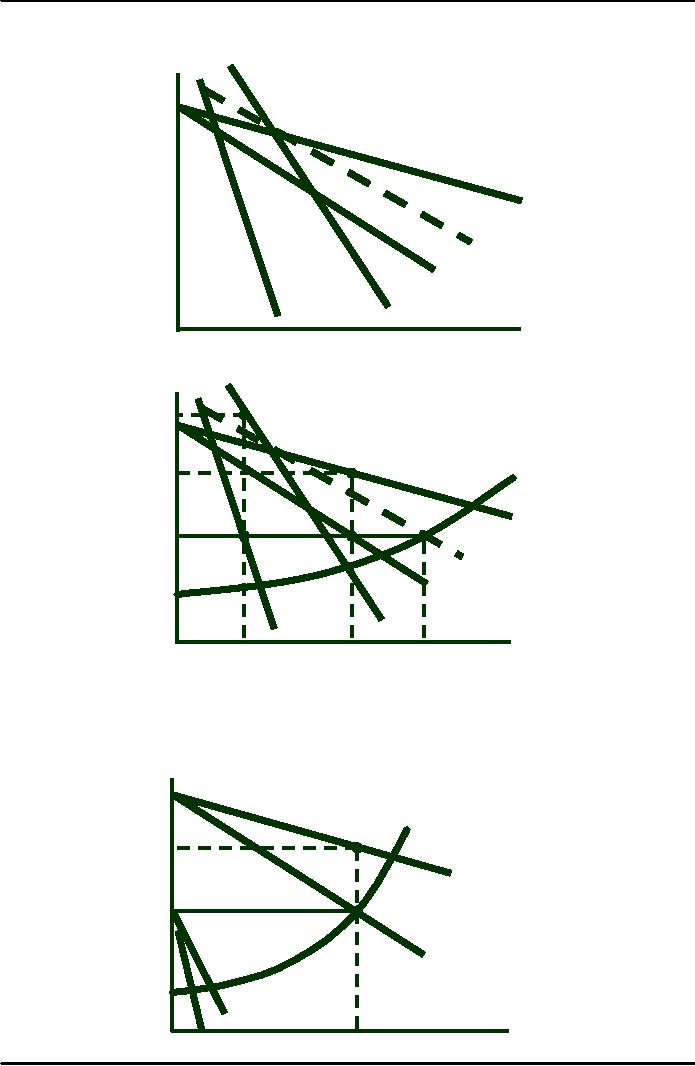 |

Microeconomics
ECO402
VU
�
Lesson
35
Third
Degree Price
Discrimination
1)
Divides the market into
two-groups.
2)
Each group has its
own demand function.
3)
Most common type of price
discrimination.
Examples:
airlines, vegetables, discounts to
students and senior
citizens.
4)
Third-degree price discrimination is
feasible when the seller
can separate his/her
market
into groups who have
different price elasticities of
demand.
(e.g.
business air travelers
versus vacation air
travelers)
Objectives
MR1 =
MR2
MC1 =
MR1 and MC2
= MR2
MR1 =
MR2 = MC
P1:
price first group
P2:
price second group
C(Qr) =
total cost of QT =
Q1 + Q2
Profit
( � ) = P1Q1 +
P2Q2 - C(Qr)
Set
incremental �
for
sales to group 1=0
Δ(PQ1) ΔC
Δ�
1
=
-
=0
ΔQ1
ΔQ1
ΔQ1
Δ(
PQ1 )
ΔC
=
MR1 -
=
MC
1
ΔQ1
ΔQ1
Second group
of customers: MR2 =
MC
MR1 =
MR2 = MC
Determining
relative prices
Recall:
MR = P (1 + 1/Ed)
Then
: MR1 = P1
(1 +
1/E1) = MR2 =
P2 (1 + 1/E2)
Determining
relative prices
(1
+
1
E
2 )
P1
=
And
:
(1
+
1
E
1 )
P2
Pricing:
Charge higher price to group
with a low demand
elasticity
Example:
E1 = -2 & E2
= -4
(1
-
1 4
)
P1
=
=
3 4 1
2 =
1
.5
(1
-
1 2
)
P2
P1 should be 1.5 times as
high as P2
163

Microeconomics
ECO402
VU
Consumers
are divided into
$/Q
two
groups, with separate
demand
curves for each
group.
MRT =
MR1 + MR2
D2 =
AR2
MRT
MR2
D1 =
AR1
MR1
Quantity
QT: MC =
MRT
MC
= MR1 at
Q1 and P1
�
$/Q
�Group 1: P Q ; more
elastic
1
1
�Group 2: P Q ; more
P1
2
2
inelastic
�MR = MR = MC C
1
2
P2
M
�Q control MC
T
D2 =
AR2
MRT
MR2
D1 =
AR1
MR1
Q1
Q2
QT
Quantity
No
Sales to Smaller
Market
Even
if third-degree price discrimination is
feasible, it doesn't always
pay to sell to both
groups
of
consumers if marginal cost is
rising.
Group
one, with
$/Q
demand
D1,
are not
willing
to pay enough
MC
for
the good to
P
make
price
discrimination
profitable.
D2
MR2
D1
Quantity
MR1
Q*
164

Microeconomics
ECO402
VU
THE
ECONOMICS OF COUPONS AND
REBATES
Price
Discrimination
Those
consumers who are more
price elastic will tend to
use the coupon/rebate
more
often
when they purchase the
product than those consumers
with a less elastic
demand.
Coupons
and rebate programs allow
firms to price
discriminate.
Price
Elasticities of Demand for
Users Versus Nonusers of
Coupons
Price
Elasticity
Product
Nonusers
Users
Toilet
tissue
-0.60
-0.66
Stuffing/dressing
-0.71
-0.96
Shampoo
-0.84
-1.04
Cooking/salad
oil
-1.22
-1.32
Dry
mix dinner
-0.88
-1.09
Cake
mix
-0.21
-0.43
Cat
food
-0.49
-1.13
Frozen
entr�e
-0.60
-0.95
Gelatin
-0.97
-1.25
Spaghetti
sauce
-1.65
-1.81
Cr�me
rinse/conditioner
-0.82
-1.12
Soup
-1.05
-1.22
Hot
dogs
-0.59
-0.77
Cake
Mix
Nonusers of
coupons: PE = -0.21
Users:
PE =
-0.43
Cake
Mix Brand A
PE:
8 to 10 times cake mix PE
Example
PE Users: -4
PE Nonusers: -2
Using:
(1
+
1
E2 )
P
=
1
(1
+
1
E1 )
P2
165

Microeconomics
ECO402
VU
Price
of nonusers should be 1.5
times users
Or, if
cake mix sells for
$1.50, coupons should be 50
cents
166
Table of Contents:
- ECONOMICS:Themes of Microeconomics, Theories and Models
- Economics: Another Perspective, Factors of Production
- REAL VERSUS NOMINAL PRICES:SUPPLY AND DEMAND, The Demand Curve
- Changes in Market Equilibrium:Market for College Education
- Elasticities of supply and demand:The Demand for Gasoline
- Consumer Behavior:Consumer Preferences, Indifference curves
- CONSUMER PREFERENCES:Budget Constraints, Consumer Choice
- Note it is repeated:Consumer Preferences, Revealed Preferences
- MARGINAL UTILITY AND CONSUMER CHOICE:COST-OF-LIVING INDEXES
- Review of Consumer Equilibrium:INDIVIDUAL DEMAND, An Inferior Good
- Income & Substitution Effects:Determining the Market Demand Curve
- The Aggregate Demand For Wheat:NETWORK EXTERNALITIES
- Describing Risk:Unequal Probability Outcomes
- PREFERENCES TOWARD RISK:Risk Premium, Indifference Curve
- PREFERENCES TOWARD RISK:Reducing Risk, The Demand for Risky Assets
- The Technology of Production:Production Function for Food
- Production with Two Variable Inputs:Returns to Scale
- Measuring Cost: Which Costs Matter?:Cost in the Short Run
- A Firm’s Short-Run Costs ($):The Effect of Effluent Fees on Firms’ Input Choices
- Cost in the Long Run:Long-Run Cost with Economies & Diseconomies of Scale
- Production with Two Outputs--Economies of Scope:Cubic Cost Function
- Perfectly Competitive Markets:Choosing Output in Short Run
- A Competitive Firm Incurring Losses:Industry Supply in Short Run
- Elasticity of Market Supply:Producer Surplus for a Market
- Elasticity of Market Supply:Long-Run Competitive Equilibrium
- Elasticity of Market Supply:The Industry’s Long-Run Supply Curve
- Elasticity of Market Supply:Welfare loss if price is held below market-clearing level
- Price Supports:Supply Restrictions, Import Quotas and Tariffs
- The Sugar Quota:The Impact of a Tax or Subsidy, Subsidy
- Perfect Competition:Total, Marginal, and Average Revenue
- Perfect Competition:Effect of Excise Tax on Monopolist
- Monopoly:Elasticity of Demand and Price Markup, Sources of Monopoly Power
- The Social Costs of Monopoly Power:Price Regulation, Monopsony
- Monopsony Power:Pricing With Market Power, Capturing Consumer Surplus
- Monopsony Power:THE ECONOMICS OF COUPONS AND REBATES
- Airline Fares:Elasticities of Demand for Air Travel, The Two-Part Tariff
- Bundling:Consumption Decisions When Products are Bundled
- Bundling:Mixed Versus Pure Bundling, Effects of Advertising
- MONOPOLISTIC COMPETITION:Monopolistic Competition in the Market for Colas and Coffee
- OLIGOPOLY:Duopoly Example, Price Competition
- Competition Versus Collusion:The Prisoners’ Dilemma, Implications of the Prisoners
- COMPETITIVE FACTOR MARKETS:Marginal Revenue Product
- Competitive Factor Markets:The Demand for Jet Fuel
- Equilibrium in a Competitive Factor Market:Labor Market Equilibrium
- Factor Markets with Monopoly Power:Monopoly Power of Sellers of Labor